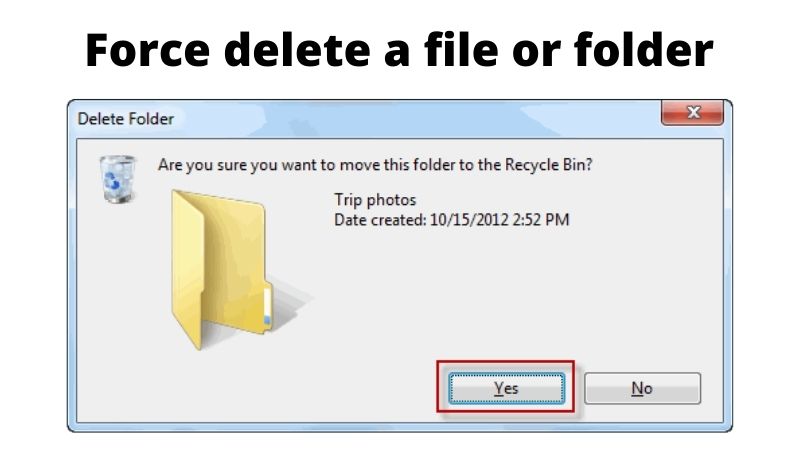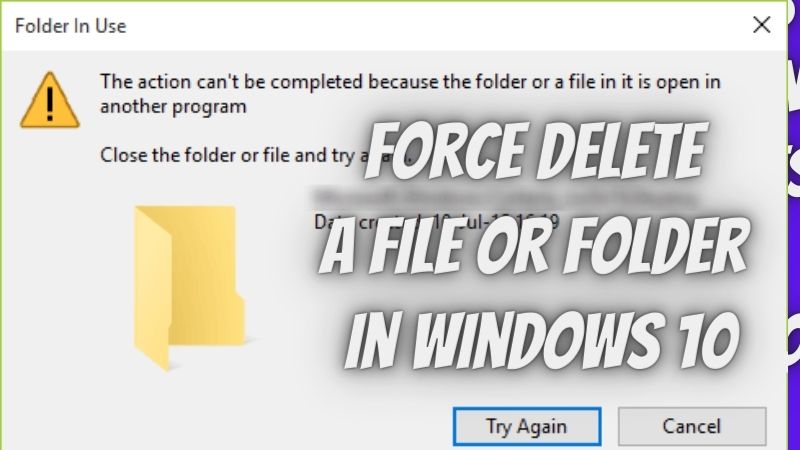Can’t Delete a File or Folder in Windows 10? Know here guide to Delete It Forcefully
All the windows users are too manageable about the storage and space of their PC or laptops. Balancing space is necessary for your device to work properly. Especially your Local Disk C should be free as much as possible. But the latest Windows versions come with a few restrictions on file and folder deletion. And it creates problems while deleting something from this system disk drive. Many times you might face this and you may not be able to delete a specific file or folder. If you’re also facing the same issue, we have the answer to your question, how to force delete a file.
Common issues while deleting a file or folder
There can be numerous reasons why you aren’t able to delete a specific file or folder. We have listed here all the common reasons that you would face. This can be mainly because you’re trying to delete a restricted file and the system is not allowing you to do so. Anyways, let’s discuss the possible causes.
- The file or folder might be being used, either by the system or by the user. Either directly or indirectly.
- The file or folder is open somewhere. Close it properly through the task manager.
- The file or folder is not allowed by the system to be deleted 1as it may contain some important stuff.
- The file or folder can’t be deleted because the disk is either full or write-protected.
- The file or folder you are trying to delete from an external drive shows the “Access Denied” problem.
- The file or folder is corrupted or read-only.
- The file or folder can’t be deleted because the recycle bin is either corrupted or full.
- The file or folder you’re trying to delete has malware or virus infection.
How to force delete a file or folder in a few basic ways

Despite all the problems that you face on how to force delete a file or folder, there are several solutions. Technically, three methods of those can certainly solve your problem. But before that, save yourself some time and effort, and try the below basic ways to solve this error.
- Firstly, ‘Restart’ is the best solution to almost all the problems that you face on any of your electronic devices.
- Secondly, you must ensure that all the files and folders on your device are closed. None should be opened anywhere.
- Thirdly, ensure that there aren’t any files or folders running in the background that you may not see. Task Manager is the best tool that you can use for this.
- Also, try running a malware or virus scan. Many files and folders fail to be deleted when they are infected by viruses.
- You can also check that the file or folder you’re trying to delete is not marked as read-only. You can do so by going on to the ‘Properties’ section.
- Lastly, make sure that your windows version is up to date. This may also be among the many reasons why you aren’t able to delete a file or folder.
Related : Top 7 Best Free File Recovery Tools for Windows
How to force delete a file or folder in three effective methods
If the above ways can’t resolve your issue, then don’t worry, we have other methods for you. Just try the below ones and they’ll work for sure.
Using the Windows Command Prompt
Windows Command Prompt is another most helpful tool through which you can resolve many of your problems. So you can also use this to delete a specific file or folder that you’re trying to delete. Just follow the below easy steps.
- Firstly, open the windows command prompt. You can do so by typing cmd in the start menu, right-click on it and click on ‘run as administrator.
- Next, type the command line that’ll delete the desirable file or folder. Just type “del” after the default command and then paste the correct destination. You can find that in the Properties section of that file or folder.
- You can also use the rmdir command. To do so, type “rmdir /s /q” after the default command. Now, just add the file or folder destination after that.
Using the Windows 10 Safe Mode
Windows 10 comes with a safe mode that helps you to unlock and delete restricted files, among many other things. To solve how to force delete a file or folder on Windows 10, you need to follow a few steps the same way as they are mentioned.
- First of all, go to the start menu. Click on Settings and then click Update and Recovery. Under Advanced Startup, you will find the ‘Restart Now’ option, click on it.
- You’ll enter the Windows Recovery Environment. There, you have to click the Advanced option under the ‘Troubleshoot’ section. Then click Startup Settings and then Restart.
- You’ll see the Startup Settings there. Now, you have to choose 4 or 5. Either press F4 to enter safe mode or F5 to enter safe mode with networking.
- Finally, you can delete that specific file or folder that you’re trying to delete for a while. After successfully doing so, you can simply restart the windows. This will exit the safe mode and normally start your device.
Read here : Top 5 PS4 Emulators for Windows PC to Install In 2021
Using the Shortcut Keys
Making use of the shortcut keys on the keyboard saves you a lot of effort and time. You can already imagine the world beyond clicks with only a keyboard attached to your device. Anyways, you can forcefully delete any file or folder too just by pressing a couple of keys. Go ahead and follow the below steps.
All you have to do is just press the Shift+Del keys on your keyboard. This will not move anything to the recycle bin but directly delete the file or folder. Using this method, you can save yourself some time and effort. Many of you may already be familiar with this shortcut.
Recovering deleted files on Windows 10
Done with how to force delete a file or folder, let’s get started with how to recover mistakenly deleted files and folders. There are some situations when you delete something important by mistake. In that case, you would wish to recover the file or to permanently delete it, if the remains are still there. So if you have genuine software, you can do both with a click. So without wasting any time, let’s get started.
MiniTool Power Data Recovery is a master solution to recover your lost data. It can be used for any file type or folder, for any external drive, SSD and USB too. There are only two steps to follow to recover any of your lost data.
- First of all, download the application on your device. Launch it, and select the ‘This PC’ option from the menu on the left. Now simply navigate to the location where your file or folder was. Start a scan and you’ll recover all the recently deleted files. You can choose a specific file type to shorten the process.
- As we already said, after the scan finishes, you’ll see all the files and folders that you deleted lately. Now, to get it back, you have to click on the ‘Save’ button. This will allow you to save your file on your device, in any location you want. Do so, and congratulations, you successfully recovered your data.
Frequently Asked Questions for how to force delete a file or folder in Windows 10
How to delete a file that can’t be deleted?
The only option left when a file or folder can’t be deleted is to force delete it. We have discussed a number of ways through which you can do it.
How to force delete a file or folder?
You can simply press SHIFT + DEL keys to force delete a file or folder. It’ll skip the Recycle Bin and permanently delete it.
How to force delete using CMD?
Open the Windows Command Prompt and just enter the “del” command with the correct destination of the file or folder.
Why can’t you delete a file or folder?
This can be due to several reasons. Either the file or folder is running in the background or opened somewhere else. We have stated other reasons too.
How to recover deleted and partially deleted files or folders?
You will need a good recovery tool to do so. MiniTool Power Data Recovery is the one that we have mentioned with detailed steps on how to recover the file or folder.
